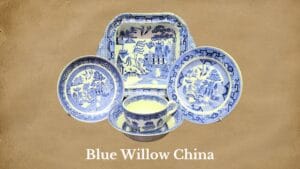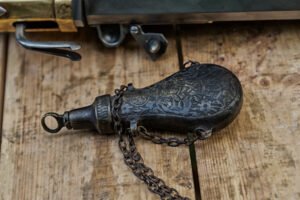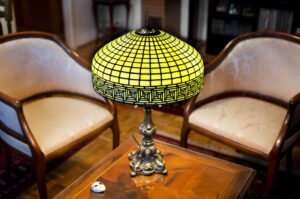Do you have an antique pottery item with a unique blue and white pattern featuring Chinese castles, a Willow tree, and a pair of doves? If yes, you likely own a highly collectible Blue Willow china piece worth a few hundred dollars! This iconic fine china design is known for its deep, cobalt blue color and interesting motifs reflecting a folk tale.
However, picking an authentic Blue Willow piece and assigning it a price tag is difficult if you don’t know its history, age, manufacturer, and rarity. In this detailed guide, you will find easy steps to identify antique Blue Willow china and assess its features to find out if it’s a real deal!
A Brief History of Blue Willow China
The Blue Willow China is antique stoneware. Its iconic blue and white pattern features interesting motifs, such as an island, castle, river, bridge, and a pair of doves. This transferware pattern depicts a romantic Chinese fable involving two star-crossed lovers who turn into a pair of doves.
The roots of the Blue Willow China pattern grow back to China during the Yuan Dynasty (1271-1368 CE) or earlier. By the end of the 18th century, this pattern rose to popularity in England, where it was being used for transferware.
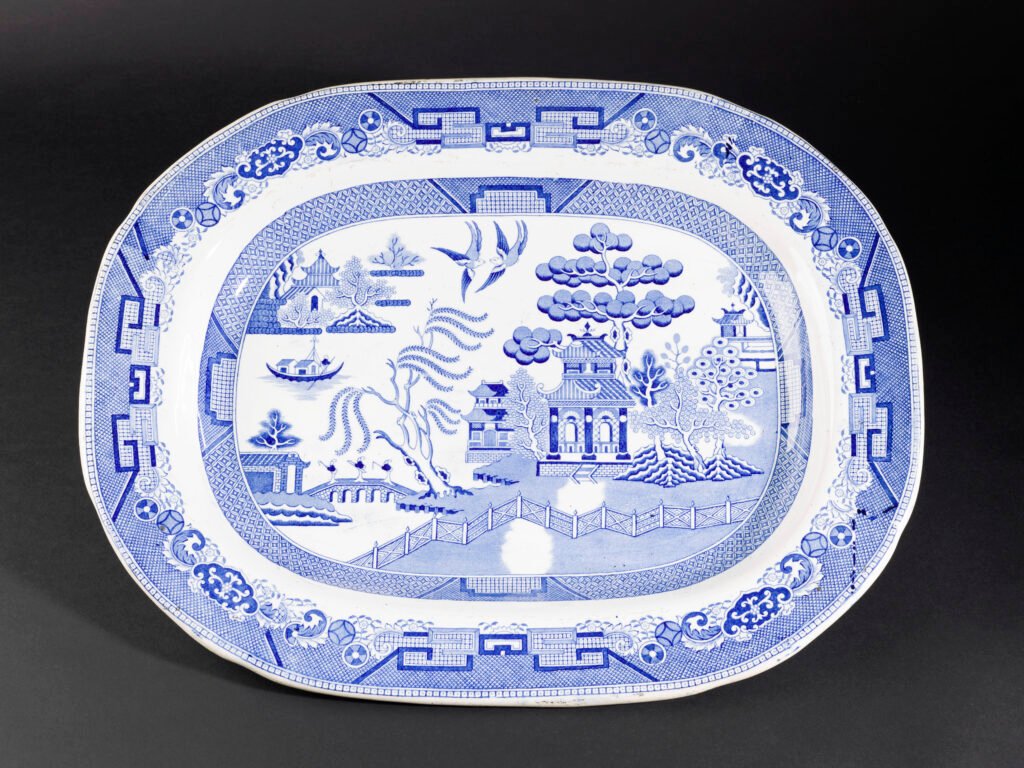
The first English version of the Blue Willow pattern is believed to have been produced by Caughley Pottery in 1780. Soon, other pottery manufacturers adapted the pattern with minor variations. With advances in transfer printing techniques, the Blue Willow English China began being mass-produced.
Finally, after a century, the pattern arrived and became popular in North America during the Victorian era. The first American pottery company to produce the Blue Willow pottery was the Buffalo Pottery Company.
While pottery companies like Churchill and Royal Stafford still manufacture the classic Blue Willow chinaware, only antique pieces from the 18th and 19th centuries are collectible and valuable today!
Identifying & Dating Blue Willow China
Since there are many blue and white vintage china pottery, like the iconic Gzhel pottery, available in the antique market, identifying authentic Blue Willow ware can be a bit tricky. But there are some key elements that you can look for.
Blue & White Color Scheme
Blue Willow China is known for its unique blue and white color theme. The unique Willow design is painted in bright cobalt blue over bright white china pottery.
Also, check if the blue pattern is hand-painted or transfer-printed. Original, hand-painted Blue Willow ware pieces are generally older and more valuable than the later transferware. Besides, older pieces may have a more faded blue color pattern due to age and firing techniques than the new ones.
The Distinctive Willow Design Motifs
This highly detailed classic pattern is characterized by its motifs that represent a romantic Chinese folk tale revolving around a wealthy Mandarin who got his beautiful daughter and her lover killed for their forbidden love, who were turned into a pair of doves by God.
Authentic Blue Willow royal china pattern must have the following elements:
- The Willow tree
- An island
- A Pagoda or traditional Chinese-style castle, temple, or building
- A fence in front of the castle
- A river
- A ship or boat in the river
- An arched bridge across the stream
- Two Chinese figures, often described as lovers (or a Mandarin couple,) on the bridge or near the Willow tree
- A pair of doves or love birds in the sky
- An apple tree
- A decorative fencing or lattice pattern framing the central pattern
If any of these main motifs of the Blue Willow china pattern is missing from your pottery, it’s like a reproduced or fake piece.
Identify the Type of Glaze
Made with ancient glazing techniques, antique Blue Willow dishes naturally feature a rough, matte glaze or satin-like glaze. The texture of this glaze may be slightly gritty as well. Similarly, the early Willow ceramic pieces may also show deep crazing (thin cracks) in the glaze.
On the other hand, more recent Blue Willow dishes are often found with a smooth, glossy glaze without any crazing or unevenness. The glaze, hence, can help you verify whether the Willow royal china pottery is antique or not!
Manufacturer & Maker’s Marks (Early Pieces)
Once the Willow pattern became popular in England in the late 18th century, many ceramics factories started making their own distinctive Blue Willow ceramics. While the Willow design may have some minor variations on the pieces made by different makers, the main design element remains the same.
Below are some of the renowned pottery manufacturers who made the iconic Blue Willow English china (recent pieces):
- English Spode Copeland (by Josiah Spode)
- Enoch Woods & Sons
- Churchill China England
- Royal Staffordshire
- Royal Doulton ‘Booths’ REAL OLD WILLOW
- Mintons (by Thomas Minton)
- Wedgewood
- Caughley
- Ridgway England
- Buffalo Pottery Company (American Company)
Remember, the earliest Blue Willow pieces are not marked. You may occasionally notice a potter’s mark or initial, but there’s no maker or manufacturer mark on the early Willow bone china pottery.
Antique Blue Willow China Value Guide
The average value of a single vintage Blue Willow ware piece ranges from $50 to $200, but rare individual pieces can fetch as much as $700 to $800 or even more. Similarly, large Blue Willow china dinner sets can be worth up to $500 to $600, while small sets are worth less.
To find the best market value of an antique Blue Willow piece, you can follow the given steps:
Identify the Manufacturer
Among the many manufacturers who make Blue Willow fine china pottery, Caughley, Spode, Mintons, and Royal Doulton (Booths) are highly sought after. One Spode Copeland Gold Gilt Plate was sold for almost $300 on eBay.
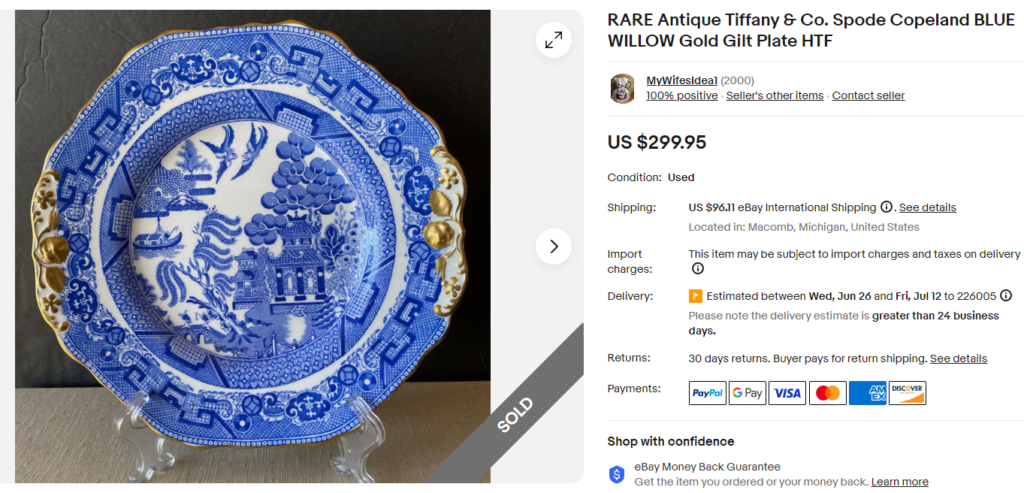
Assess the Condition:
Antique Blue Willow Pieces in undamaged, excellent condition are worth the highest. Look for any damage like cracks, chips on the edges, deep scratches on the pattern, repairs, and repainting, which can devalue your antique piece.
Track the Age:
Age is a deciding factor when assessing an old Blue Willow china piece. Generally, antique pieces from the 19th century are more collectible and valuable than the later 20th or 21st century Blue Willow pieces.
Measure the Size:
Naturally, larger Blue Willow porcelain pieces fetch higher returns than the small pieces. For example, I found a 17-inch Blue Willow serving tray that sold for about $370 and a longer 19-inch tray that sold for $395 on eBay.
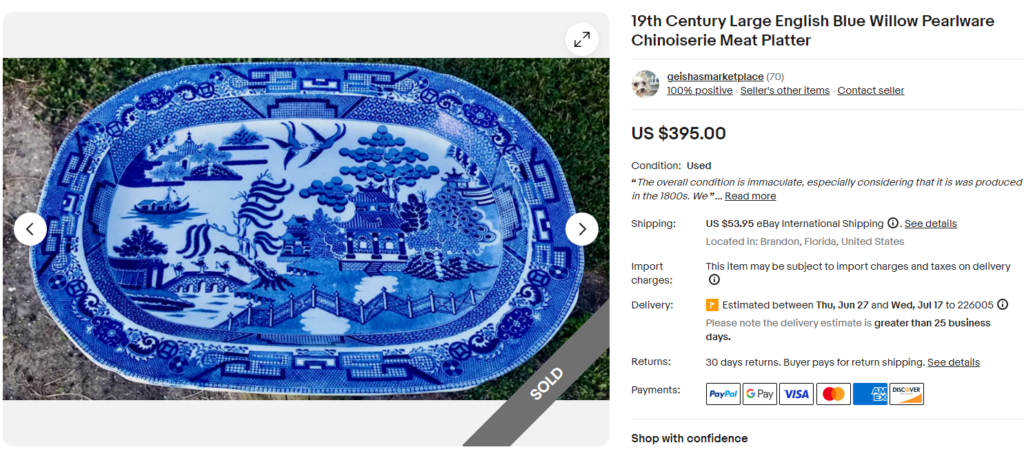
Similarly, larger sets of Blue Willow ware with more pieces might be worth more than smaller sets. However, the value of sets also largely depends on the manufacturer and the condition of the pieces.
Most Valuable & Rare Blue Willow China Ever Sold!
1. Antique Blue Willow Gilded Drum Teapot (Sold for $750)
Tableware pieces like teapots with the Blue Willow classic pattern are rare to find. For example, a 5-inch tall antique Chinese Qing Dynasty’s Blue Willow royal china gilded drum teapot was sold for almost $750 on Etsy!
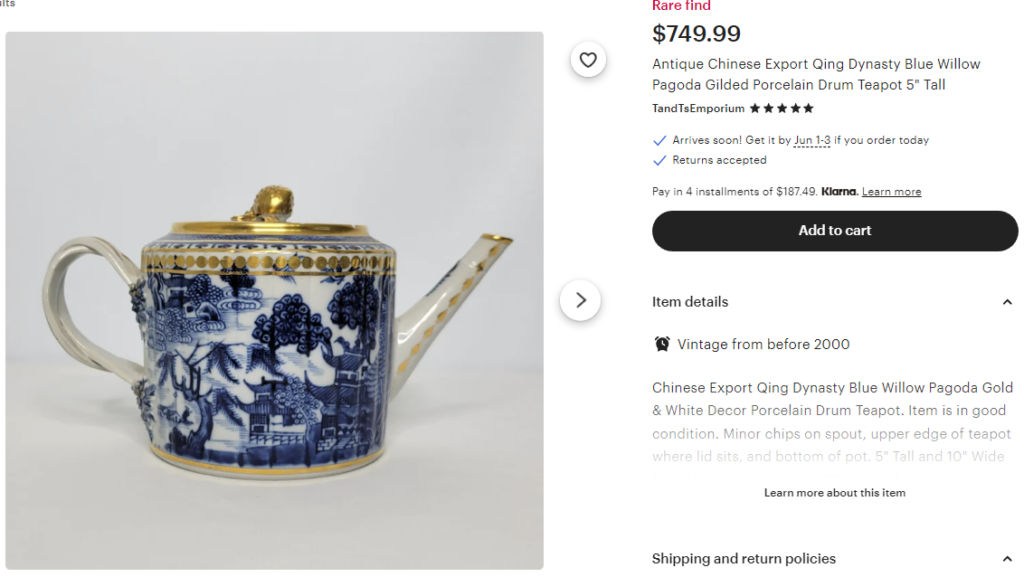
2. 1880s Minton’s Gilded Blue Willow Plate (Sold for $603)
White regular rectangular Blue Willow dishes and trays can sell for anywhere from $100 to $400, a rare 1881 Minoton’s gilded square plate/tray is sold at a high bid of $603.
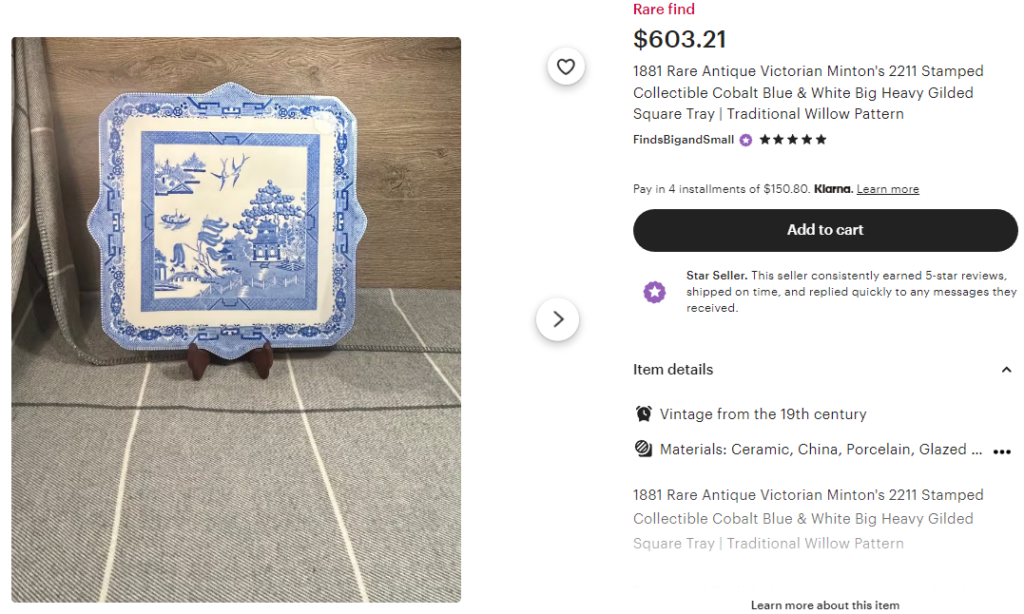
3. A 72-piece Churchill China Blue Willow Dinner Set (Sold at $600)
A Churchill England Blue Willow fine china complete dinnerware set with 72 pieces, including teacups, saucers, dinner plates, serveware, bowls, teapots, creamers, and a wall clock plate, is available for a whopping $600 on eBay!
4. Blue Willow Two-Piece Meat Platter (Sold at $573)
An antique two-piece meat platter set with a drain plate featuring the original Blue Willow design sold for $573 on Etsy. The dishes are large in size and are in excellent condition, justifying its hefty price.
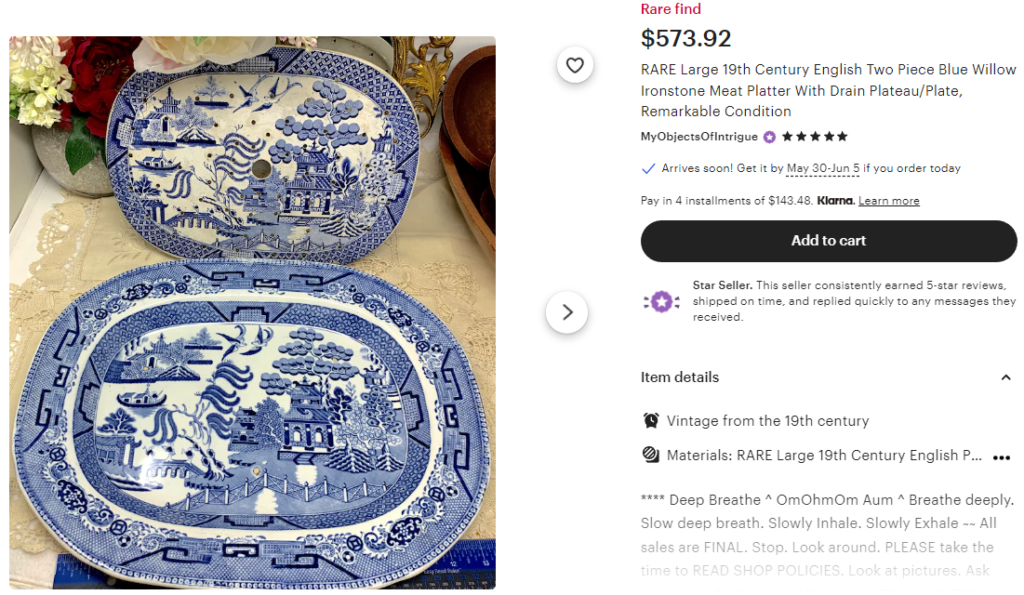
5. A 19th Century Willow Soup Tureen (Sold at $524)
An extra-large soup tureen from the 19th century featuring the Blue Willow pattern is available on Etsy at the stunning price of $524. The tureen has a painted J M P Bell & Co Glasgow trademark on the bottom!
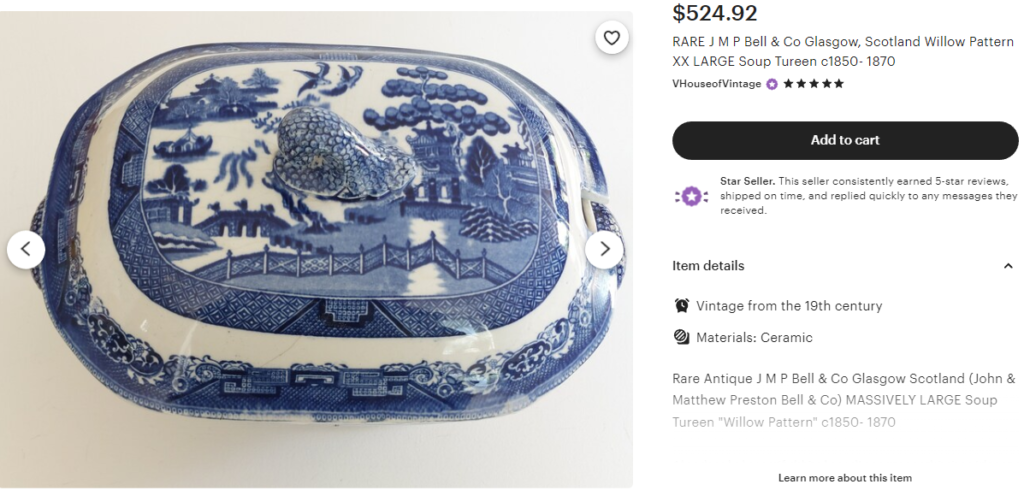
6. A Royal Doulton Gilded “Booths” Soup Tureen (Sold at $375)
A rare fine china Blue Willow soup tureen by Royal Doulton’s Booth line sold for $375. This antique piece is heavily gilded at the edges of the tureen, handles, and lid and stamped with the “Royal Doulton Booths” mark at the bottom.

Among many classic blue-and-white antique china, Blue Willow ware is one of collectors’ favorites today! So, if you have those old white-blue-printed dishes, take them out and use this guide to identify and appraise them. Another blue-and-white china design that is highly collectible today is the iconic Flow Blue China!
Note: This article is intended for informational, educational, and entertainment purposes only. Some images are illustrative and may not represent actual brands, products, or related entities. All trademarks, product names, brand logos, packaging, and other intellectual property referenced remain the exclusive property of their respective owners. Any brand mentions or references are provided solely for descriptive and educational context and do not imply any formal or commercial association.

